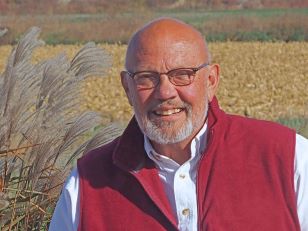Someday, I’m going to put this one on canvas.
I know–it’s no stunner, but I loved the image before I saw it through the screen on my phone. I wanted to get a shot of it from the minute I was told that out there in the pasture across the gravel was a chunk of concrete that once formed the stairway into an old Catholic church. Today, a battle-worn tree almost obscures those lop-sided steps, but then out there on the plains life is demanding. It’s a landscape that once created millions of dreams, most of which died there just as surely.
Something about the image suggests that. So much of the fascination I feel for “the Great Plains” is here in this little iconic spot of Dakota ruins.

Rev. Leonard Verduin, a man I revered at a moment in my own life when I probably needed him, grew up here long ago. He used to talk about the neighborhood with the kind of reverence we reserve for home. He wasn’t reserved about treacheries he’d never forget, the sins of his own people, the Dutch Reformed who picked up reservation land once the Dawes Act turned the Great Sioux Reservation into 160-acre plots and opened all that land up for white settlement. We’re in Spotted Tail’s country here, on the Rosebud reservation, among the Brule Sioux.
People dreamed great dreams here, Brule’ people, Dutch Calvinists, and black-robed Roman Catholics alike. I had no idea there’d once been a Catholic church pretty much right across the road from a Lakeview CRC. What’s left today is a skeletal tree growing–sort of–from a stairway leading nowhere. And it seemed little more than that, but I’ve been reading a ton lately. . .

I found this map in a book about Lakota Sioux Missions. Sure enough, there’s Lakeview, the church with the steps. It was named Sacred Heart, one of six Catholic stations that went by that name on the reservation.
St. Francis Mission established satellite parishes, tiny places to do mass and distribute the Holy Eucharist when circuit riding priests could get out there. Churches like the one that once stood here were run by catechists, Native men empowered to teach the Christian faith as they practiced it as a new Catholic way of living meant to replace a culture and language that had been destroyed by the white man.
But there’s more.

A man whose life story I’ve tried to understand once lived somewhere near. He listed Lakeview, SD, as his birthplace when he enlisted in Army sometime during World War II. He returned from the France without his legs, lost them when a German tank came up suddenly and took out foxhole. He had graduated from high school at the mission of St. Francis and was in all likelihood, Roman Catholic. When he was a boy, a disabled and decorated war veteran named Eugene Robideaux walked up those cement steps into church, the Verduins just down the road.

Once upon a time right here in the old Catholic church, Black Elk may well have preached the gospel, the Black Elk of Black Elk Speaks, the Ogalalla holy man who begat, some historians say, a kind of Great Awakening among his people while visiting a score of Black Robe missions. Black Elk converted to Catholicism but never really tossed the old ways. Today, Black Elk, who watched at the Little Big Horn and carried a rifle at the massacre at Wounded Knee, is being considered for sainthood, a holy man, which he was, in a way, in two cultures, two faiths.

During Leonard Verduin’s boyhood, Katharine Drexel, the heiress whose immense fortune constructed so much on Native reservations throughout the country, may have walked up those steps too. She and her sisters loved visiting the out of the way reservation places around the turn of the century. In 2000, the Vatican determined Katharine Drexel to be a saint for what she did for Indian missions. Her feast day was Monday, March 3.
Almost certainly, other “religious” visited would have come to this long-gone church, many of them immigrant European women with no idea what an American Indian reservation looked like. One of them, a postulant, wrote this to her Irish mother: “This is real prairie land—something you could never envision. Trees are miles apart and very sparse. Hills and valleys do not exist here, and one is often awakened at night by howling of the prairie dogs and coyotes.”
To me at least, all of that is still somewhere here–and there, just across the gravel road, a woebegone tree and a tipped chunk of concrete. Amazing.
That’s why I’ll put it on canvas.


